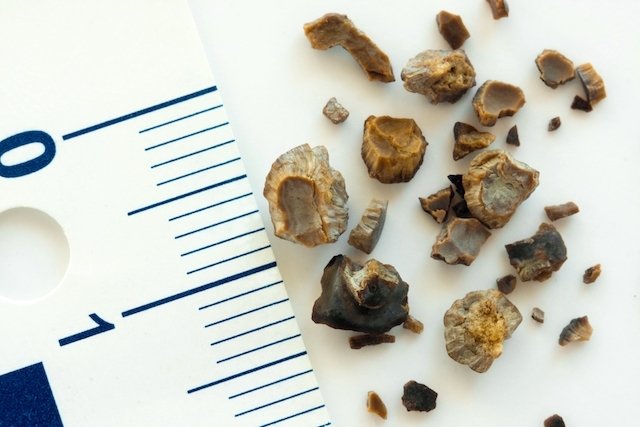Kidney stones are a hardened mass that forms inside the kidney, and can move throughout the urinary system, causing symptoms such as intense pain in the lower back, nausea, vomiting, pain when urinating, blood in the urine, cloudy urine or fever.
The risk of having kidney stones is greater in people who eat a diet very rich in sodium, protein, potassium, phosphorus or calcium, but it can also be the result of changes in kidney function, low fluid consumption or genetic predisposition.
The treatment of kidney stones is carried out by a nephrologist or urologist with the aim of relieving symptoms and eliminating the stone, and the use of medication, lithotripsy or surgery may be indicated.
Sensitive content
This image may contain content that is uncomfortable for some people.

Kidney stone symptoms
The main symptoms of kidney stones are:
- Pain in the lower back that can limit movement;
- Back pain that can radiate to the groin;
- Cloudy and bloody urine, in some cases;
- Frequent urge to urinate;
- Pain when urinating;
- Fever.
Furthermore, in cases where there is obstruction of the channel through which urine passes, the person may stop urinating, increasing pain and discomfort.
Kidney stone symptoms are more common when the stone is very large or when it moves through the urinary system, varying in intensity according to the stone’s location. Learn more about kidney stone symptoms.
How to know if I have kidney stones
To find out if you have kidney stones, indicate the symptoms you have in the symptom test below:
The symptom test is only a guidance tool and does not serve as a diagnosis or replace consultation with a nephrologist or urologist.
How to confirm the diagnosis
The diagnosis of kidney stones is made by a nephrologist, urologist or general practitioner through evaluation of symptoms and imaging tests, such as ultrasound and abdominal tomography.
The exams also allow you to identify the size of the stone and its location, which are important data so that the treatment is correctly adapted.
Make an appointment with the nephrologist in the region closest to you:
Taking care of your health has never been easier!
The doctor may also recommend a urinalysis to investigate the concentration of electrolytes in the urine and the composition of the stone, to indicate the most appropriate treatment.
Types of kidney stones
Kidney stones can be formed by different substances, such as calcium, uric acid, cystine or struvite, for example.
Thus, the main types of kidney stones are:
- Calcium Oxalate Stones: is the most common type of kidney stone, with an envelope or halter shape, generally related to an increased consumption of foods rich in calcium oxalate, leading to an increased elimination of calcium and oxalate in the urine, for example;
- Calcium Phosphate Stones: is another type of kidney stone formed by calcium, having the shape of its wedge cousins;
- Uric acid stones: uric acid stones are diamond-shaped and are formed mainly due to a diet rich in proteins;
- Struvite Stones: this type of kidney stone, also known as magnesium ammonium phosphate stones, is shaped like a coffin lid and is caused by bacterial infections;
- Cystine stones: This type of kidney stone is shaped like a hexagon and is mainly caused by genetic factors that alter the transport of cystine, which is an amino acid, resulting in increased elimination through the urine.
The type of kidney stone is identified by the doctor through diagnostic tests, and is important to guide the most appropriate treatment and prevention of new kidney stones. See the main types of kidney stones and what to do to avoid them.
Read too: How to know if it’s a kidney stone (and what tests to take)
Causes of kidney stones
The appearance of kidney stones can be influenced by several factors, the main ones being:
- Little fluid intake, which makes urine more concentrated;
- Food rich in protein and/or sodium and low in fiber;
- Recurrent urinary infection;
- Genetic predisposition;
- Inflammatory bowel diseases;
- Hyperparathyroidism;
- Obesity and sedentary lifestyle;
- Recurrent use of aspirin, antacids and diuretics.
Furthermore, kidney stones can also be caused by rare diseases such as primary or secondary hyperoxaluria, for example, in which there is an accumulation of oxalate in the body due to a deficiency in enzymes responsible for metabolizing this compound, favoring the accumulation of oxalate and kidney stone formation.
How the treatment is carried out
Treatment for kidney stones must be carried out under the guidance of a nephrologist, urologist or general practitioner, and varies depending on the size and location of the stone, its composition, and severity of symptoms.
The main treatments for kidney stones are:
1. Kidney stone remedies
Kidney stone medications, such as diclofenac, paracetamol, tramadol or scopolamine butylbromide, are indicated to alleviate the renal colic crisis.
Read too: Renal colic crisis: symptoms, causes (and what to do)
Another remedy that may be recommended by your doctor is tamsulosin, which acts by promoting relaxation of the ureter muscles, facilitating the elimination of stones measuring between 4 and 10 mm, when found in the ureter.
In addition, the doctor may also recommend medications to prevent kidney stones formed by calcium, such as hydrochlorothiazide or chlorthalidone, for example. See all kidney stone remedies.
2. Surgery
Surgery for kidney stones is indicated for stones larger than 6 mm or if they are blocking the passage of urine, and can be performed by the doctor using different techniques, which varies depending on the location of the stone.
Thus, extracorporeal lithotripsy, percutaneous nephrolithotomy or ureteroscopy, for example, may be indicated. See how kidney stone surgery is performed and what recovery is like.
3. Diet for kidney stones
Diet for kidney stones should be done with the guidance of a nutritionist and foods rich in water are generally recommended, such as cucumber, chayote or watermelon, in addition to increasing water intake, to facilitate the elimination of the stone. Check out the complete list of foods rich in water.
Furthermore, you should avoid salt in your diet and reduce the amount of protein consumed on a daily basis, for example, to prevent the formation of kidney stones.
Read too: Kidney stone diet: allowed foods and what to avoid
4. Natural treatment for kidney stones
Natural treatment for kidney stones, such as drinking stonebreaker tea or hibiscus tea, helps to increase urine volume to facilitate the elimination of the stone, in addition to having an anti-inflammatory action, which helps to alleviate symptoms.
Read too: 5 juices to expel kidney stones
However, it is important to emphasize that natural treatment does not replace treatment recommended by a doctor. Therefore, it is always recommended to consult a nephrologist to investigate the cause of the formation of the stones and prevent new crises from arising again.
Watch, in the following video, some precautions to avoid kidney stones:

Sign up for our newsletter and stay up to date with exclusive news
that can transform your routine!
Warning: Undefined array key "title" in /home/storelat/public_html/wp-content/plugins/link-whisper-premium/templates/frontend/related-posts.php on line 12
Warning: Undefined array key "title_tag" in /home/storelat/public_html/wp-content/plugins/link-whisper-premium/templates/frontend/related-posts.php on line 13




